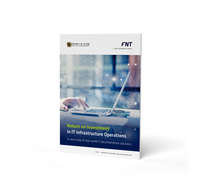What is a configuration management database (CMDB)?
A CMDB – or configuration management database – is a central database that contains all the data required for an organization to track and control its IT resources and services across the enterprise. It ensures that the organization knows how its technology assets are configured and how those items relate to one another, including information on the type and state of all configuration items (CIs). Every element of the IT infrastructure, whether hardware, network, software, or service, is a CI.
CMDB software doesn’t just contain data on network components, applications, hardware, and services. It also shows all the relationships between the CIs, across all levels of the IT stack. This enables CMDB users to identify dependencies faster and more easily, whether they’re tracing faults, carrying out maintenance, planning upgrades, or taking part in an emergency simulation.
It’s important to be aware that not every detail needs to be stored in CMDB tools itself. In many cases, linking to adjacent systems, such as a network monitoring solution, is sufficient.
Main components of a CMDB
Representing all elements of an IT infrastructure, including hardware, software, networks, services, and even personnel or contractual data. Each CI contains metadata such as version, status, and relationships to other CIs. Visualizations of CIs provide a clear, interactive way to explore these elements and their connections, helping to optimize IT asset management and improve overall infrastructure oversight.
Consolidating and synchronizing data from diverse sources - such as monitoring tools, asset management systems, and service desks - through bi-directional interfaces to enable seamless data exchange and eliminate silos.
Supporting IT service management (ITSM) processes such as incident, problem, and change management while enabling automation, facilitating compliance audits, and optimizing IT operations through structured workflows and governance controls.
Providing insights into the performance, health, and efficiency of IT assets by collecting, analyzing, and visualizing data from various sources. Metrics and analytics enable organizations to track key performance indicators (KPIs), identify trends, and make data-driven decisions to improve IT operations, reduce costs, and enhance service delivery.
Mapping and understanding how different components interact for impact analysis, troubleshooting, and change management.
What are the benefits of using a CMDB?
IT organizations need a comprehensive CMDB tool to document and track their configuration items (CIs). This enables them to maintain an overview of their complex IT infrastructure, ensure efficient management and pave the way for automation.
FNT's Configuration Management Database (CMDB) creates a central repository that contains all the important information about all the CIs in your IT landscape. Every element of the IT infrastructure is a CI, regardless of whether it is hardware, networks, applications, or services. FNT’s CMDB also contains all relevant contract, license, and personnel data. In addition, the solution maps the relationships and dependencies between CIs across all levels of the IT stack. In combination with comprehensive visualization options, organizations gain a deep and comprehensive insight into the IT infrastructure.
Thanks to extensive interfaces for bidirectional data exchange with other tools, FNT's CMDB automatically consolidates content from distributed or specialized databases, displays cross-silo dependencies and merges them into a single point of truth. The result is a digital twin of the entire IT infrastructure in one system – updated daily, manufacturer-independent and without excessive maintenance effort.
In addition, FNT’s CMDB includes modern management functionalities ranging from analysis and visualization to planning and process management.

Would you like to see how FNT’s CMDB Software works?
FAQ: CMDB Software
Requirements will vary depending on an organization’s needs. They will also vary depending on which parts of the infrastructure will be included, as each will have its own set of requirements. As a general rule, since enterprises use a wide range of applications and systems, the ability to integrate data into the CMDB from diverse tools via interfaces is an essential requirement. And if the infrastructure includes cloud environments, the CMDB must support hybrid infrastructures.
Below is a list of other common requirements of a CMDB:
- be usable by any industry or sector
- support business-critical operations
- offer a variety of interfaces to a wide range of systems
- allow agile, flexible mapping of specific requirements
- be mappable both in the cloud and on-premises
- provide all relevant information for critical service processes
- supply up-to-date, accurate data
CMDB is critical for effective IT Asset Management (ITAM) because it provides a centralized view of all IT assets and their dependencies. By maintaining accurate asset data, organizations can optimize resource utilization, reduce risks, improve compliance, and streamline IT operations. A well-maintained CMDB enhances visibility, supports automation, and accelerates issue resolution, making ITAM more efficient and cost-effective.
A CMDB supports ITIL by providing a centralized, real-time repository of IT assets and configurations, enabling efficient IT Service Management (ITSM). It enhances key ITIL processes, including:
- Incident Management – Quickly identify affected assets to speed up issue resolution
- Problem Management – Analyze root causes by tracking asset relationships and dependencies
- Change Management – Assess risks and plan changes effectively with accurate configuration data
- Asset & Configuration Management – Maintain an up-to-date inventory of IT assets and services
- Service Impact Analysis – Predict the effects of changes or incidents on business operations
By improving visibility, reducing downtime, and streamlining workflows, a CMDB helps organizations implement ITIL best practices for optimized IT service delivery.
Would you like to know more about CMDB? Then you might be interested in the following:

Enter your email address to receive regular updates about FNT and our products:









